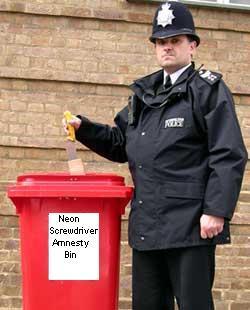Here's an odd one for you older and wiser electricians out there:
Was in the loft having pulled a disused supply to the garage back into the attic. Used a test screwdriver to test it for live & not live before moving it, and again not live & live once it had been brought into the loft to terminate it in an Ashley junction box for possible future alternative use.
Before moving the cable, the test screwdriver found the normal one live (red) at its extremity. After moving the cable, the test screwdriver found 3 lives, i.e, red, black and protective earth, again at its extremity!
That circuit is on a 30mA RCD (which did not trip) with 32A MCB (which did not 'blow' either).
As a precaution, I then removed most of the cable which had been pulled-in, because it had been on a broken catenary and it was conceivably but remotely possible that the neutral and earth had both been stretched and perhaps broken and in contact with the live. I even stripped off the outer PVC sheath to try to find evidence of stretching or cross-connection. Nothing found, and the inner sheaths and wires (2.5mm2) were in very sound condition, and had continuity (tested). So I think that we can rule out a faulty cable.
After removing most of the old cable and terminating it in the Ashley junction box, all was normal according to the test screwdriver, with just the red showing live, and everything is back on and working normally.
So it's a bit of a mystery.
It was very hot and humid up in the loft, could that have affected the operation of the test screwdriver to give a result which showed 3 apparent lives on that one occasion but did not trip the RCD?? (The screwdriver is the sort where you press your thumb against a metal button to light the neon if there is a live contact.)
If not, what else?
The test screwdriver, RCD, and MCB all appear to be functioning normally, and the other items on that particular circuit are also working normally, and properly connected as far as I can establish.
Was in the loft having pulled a disused supply to the garage back into the attic. Used a test screwdriver to test it for live & not live before moving it, and again not live & live once it had been brought into the loft to terminate it in an Ashley junction box for possible future alternative use.
Before moving the cable, the test screwdriver found the normal one live (red) at its extremity. After moving the cable, the test screwdriver found 3 lives, i.e, red, black and protective earth, again at its extremity!
That circuit is on a 30mA RCD (which did not trip) with 32A MCB (which did not 'blow' either).
As a precaution, I then removed most of the cable which had been pulled-in, because it had been on a broken catenary and it was conceivably but remotely possible that the neutral and earth had both been stretched and perhaps broken and in contact with the live. I even stripped off the outer PVC sheath to try to find evidence of stretching or cross-connection. Nothing found, and the inner sheaths and wires (2.5mm2) were in very sound condition, and had continuity (tested). So I think that we can rule out a faulty cable.
After removing most of the old cable and terminating it in the Ashley junction box, all was normal according to the test screwdriver, with just the red showing live, and everything is back on and working normally.
So it's a bit of a mystery.
It was very hot and humid up in the loft, could that have affected the operation of the test screwdriver to give a result which showed 3 apparent lives on that one occasion but did not trip the RCD?? (The screwdriver is the sort where you press your thumb against a metal button to light the neon if there is a live contact.)
If not, what else?
The test screwdriver, RCD, and MCB all appear to be functioning normally, and the other items on that particular circuit are also working normally, and properly connected as far as I can establish.



